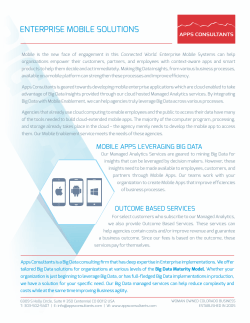
The most powerful open source data science
The most powerful open source data science technologies in your browser. ! ! Yves Hilpisch I. The Market and The Problem II. How We Solve The Problem III. Market Size and Facts IV. Strategic Opportunities Mega Trends Mega trends that influence data science Today’s standard is “open source”, even for key technologies. More and more data sets are “open and free”. Complex analytics work flows are coded in the browser. Dynamic communities shape the way knowledge is transmitted Individuals and institutions store more and more data in the cloud. Infrastructure is a standardized commodity, billed by the hour. Open Source Software Revolution OSS revolutionizes data science both in the front & back end FRONT END In the front end, OSS revolutionizes how data scientists and developers work on a daily basis. BACK END In the back end, OSS revolutionizes how analytics workflows and data applications are deployed and scaled. “DigitalOcean is a simple and fast cloud hosting provider built for developers. Customers can create a cloud server in 55 seconds, and pricing plans start at only $5 per month for 512MB of RAM, 20GB SSD, 1 CPU, and 1TB Transfer.” The Problem Obstacles to using OSS for data science Open Source fast changing environment Vendors & Partners almost no vendors that provide help & support Libraries huge amount of libraries to manage Tools multitude of useful standalone tools Deployment complex, lengthy, costly, risky Maintenance how to update, maintain infrastructure? Diverse End Users computer & data scientists as well as domain experts Training how to train and re-train people? Start where and how to start, who to talk to? I. The Market and The Problem II. How We Solve The Problem III. Market Size and Facts IV. Strategic Opportunities datapark.io Open source data science technologies in your browser Tools and technologies data scientists know and love. Browser-based Data Science datapark capitalizes on new Web technologies and tools ! 1. Generation: Move Data Around — data analytics started by moving data from one place to another, analyzing it locally and moving results back to the remote data source 2. Generation: Move Code Around — moving tons of data is costly and time consuming; moving small code sets is faster and less costly 3. Generation: Don't Move Anything — the Browser and Web technologies allow to work directly and in real-time on the infrastructure where data and code are stored (replacing e.g. remote ssh access) Feature Rich datapark is essentially a data scientist’s wish list The Platform Bringing the best of Open Source together in the browser “Absorb what is useful, discard what is not,! and add what is uniquely your own.”! —Bruce Lee PRIMARY USE Natural Evolution From Python for Finance to Open Source for Data Analytics PYTHON DATA ANALYTICS PYTHON QUANT PLATFORM QUANT PLATFORM TECHNOLOGY I. The Market and The Problem II. How We Solve The Problem III. Market Size and Facts IV. Strategic Opportunities Data Scientists and Engineers There are about 10mn people in technical computing Source: diverse Web resources; in mn people Data Analytics Data analytics is a top priority of almost any organisation “Companies will spend an average of $7.4M on data-related initiatives over the next twelve months , with enterprises investing $13.8M, and small & medium businesses (SMBs) investing $1.6M. ! 80% of enterprises and 63% of small & medium businesses (SMBs) already have deployed or are planning to deploy big data projects in the next twelve months. ! 83% of organizations are prioritizing structured data initiatives as critical or high priority in 2015, and 36% planning to increase their budgets for data-driven initiatives in 2015.” Source: http://www.forbes.com Open Source Data Science OS languages dominate data science these days fastest growing Poll data from August 2014. Source: http://www.kdnuggets.com Open Source Data Science R, Python and SQL dominate OS data science Poll data from August 2014; usage in %. Source: http://www.kdnuggets.com Vendor Criteria in Data Analytics Integration, security, ease of use & scalability important open in all directions decades of Linux only standards Docker, Cloud Source: 2015 Big Data Analytics Survey (Summary Slides) Platform Competitors … … trying to solve the platform problem for data scientists Proprietary Notebook solution, closed platform. sense.io SQL focus, closed platform. modeanalytics.com Python focus, cloud version not maintained. wakari.io Major Competitor The major competitor is Jupyter deployed in the cloud How to maintain, how to ensure security, how to share, how to control? DigitalOcean droplet for 5 USD p.m., Jupyter with Python 3.4, deployed via Docker for 20+ users The MVP: http://jupyter.quant-platform.com I. The Market and The Problem II. How We Solve The Problem III. Market Size and Facts IV. Strategic Opportunities Use Cases for datapark.io From teaching to data science to a social app store Teaching Programming & Data Science Data Science Platform in Institutions and Corporations Analytics-as-a-Service for Open Source Projects and Proprietary Data and Code Market Place for Ideas, Projects, Apps etc. (“Social Data Science”) Establishing a Standard Building critical mass & social components, improve scalability Goal of 100,000 users to learn from Building out Social Components Improving Deployment and Scalability Becoming the Github for Data Science How do we want to reach our goals Making usage as simple as possible based on standards Sign-up Two fields only — 30 seconds, immediate full fledged functionality Infrastructure Well established components — Ubuntu, Anaconda, Docker, … Tools All that you know & love — IPython Notebook, ACE, Shell (Git, Vim), … Open Using standards only — IPYNBs, Linux FS, Dropbox, Drive (easy in/out) Just try it. http://datapark.io Give us feedback. team@datapark.io ! Dr. Yves J. Hilpisch ! datapark.io | team@datapark.io | @dataparkio ! The Python Quants GmbH
© Copyright 2025














